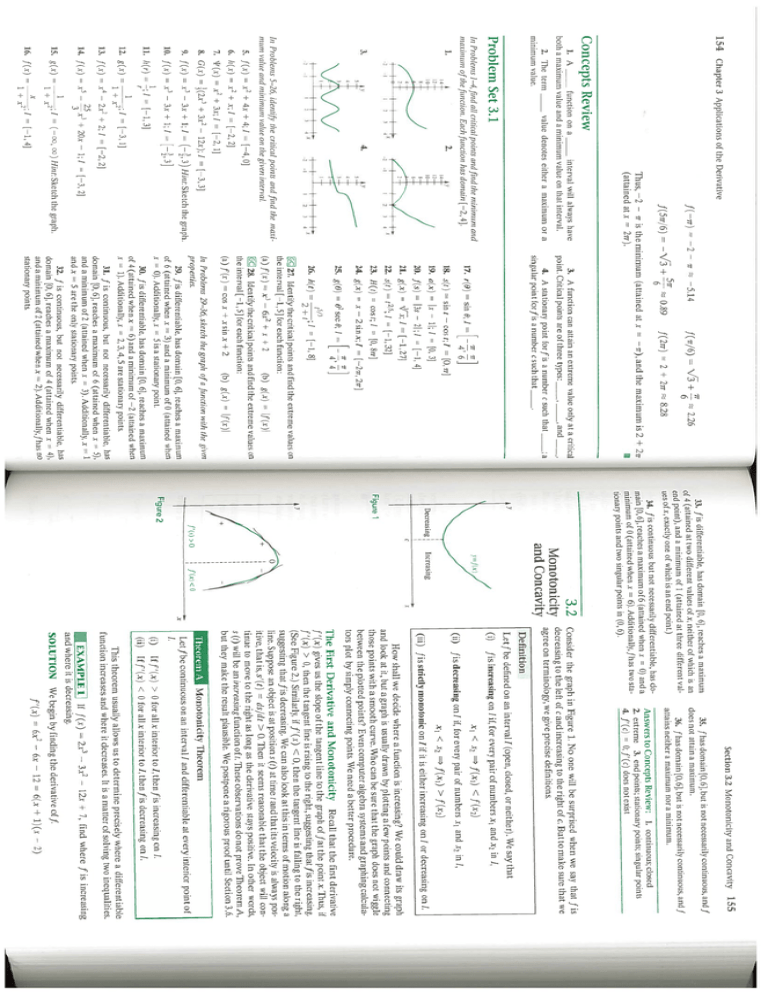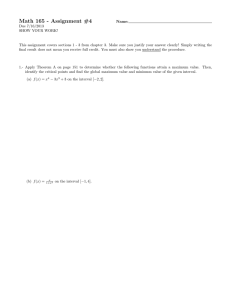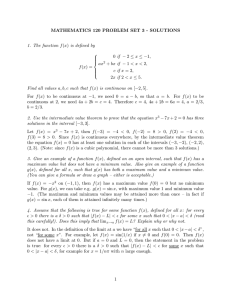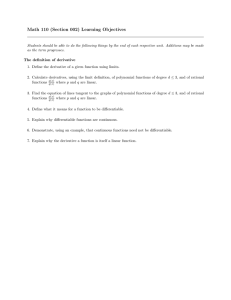Problem Set 3.1
advertisement

2 1’ 1 s5 1 = + 3x; I + x;I 2. [—2, 1] [—2,2] = = = I [—,3] [—3,1] [—1.3] = [—2,2] I —l = II 36- I [—3,2] f(—ir) — = f(5w/6) I I 3 I 2 — — H- —2 = + 3x 2 — 12x); I [—3,3] — 35 + 1; 1 (—, 3) Hint:Sketch the graph. = —3s ± 1;I I ’ 2 +x = [—1,4] (—,)Hint:Sketchthe graph. + 20x— 1;I — 252 + 2; 1 _3 = 2;I = +s2’’ x 1 + —5,14 0.89 19. a(x) IS. s(t) = = = = r(9) = 20. f(s) f(r/6) 2 + 2n \/ + 2.26 8.28 —ir), and the maximum is 2 + 2 p f(2) = = [O,n-] [0, 3] = [—i, :] = cos t;I II; I — sin 0; 1 — sinr Ix — I = [0, 87T] [—1,32] = = [—2r, 2w] 21;I = [—1,4] 13s /Z:J=[—1.27] 2 t cost; I = = ‘; 23. R(t) x 3 / 5 t — = [—1,8] =2sec0;i=[_i..] — 2sinx;1 = = cos x + sin + 2 (b) g(x) = f(x)I a 32. f is continuous, but not necessarily differentiable, has 1), domain [0, 6], reaches a rnaximnuni of 4 (attained when x and a minimum of 2 (attained when .x = 2). Additionally, f has i1 stationary points. 29. f is differentiable, has domain [0, 6], reaches a maximum of 6 (attained when s 3) and a minimum of 0 (attained when x 0). Additiona liv, x 5 is a stationary point. 30. f is differentiable, has domain [0, 6], reaches a maximum of 4 (attained when x = 6) and a rniriimuni of —2 (attained when x 1). Additionally, x = 2, 3. 4,5 are stationary points. 31. f is continuous, but not necessarily differentiable, has 5), domain [0. 6]. reaches a maximum of 6 (attained when s 1 3). Additionally, x and a minimum of 2 (attained when x and x 5 are the only stationary points. in Problems 29—36, sketch the graph of a fiuriction with the given properties. (a) f(s) 6x2 + x + 2 (a) f(s) = (b) g(s) 28. Identify the critical points and find the extreme values on the interval [—1,5] for each function: 27. Identify the critical points and find the extreme values on the interval [—1,5] for each function: 26. h(t)=—;J 25. 24. g(x) 22. s(t) 21. g(x) 17. 4. A stationary point forf is a number c such that singular point forfis a number c such that 3. A function can attain an extreme value only at a critical and point. Critical points are of three types: .__, is the minimum (attained at s Thus, —2 1T). 2 (attained at x 154 Chapter 3 Applications of the Derivative Concepts Review value denotes either a maximinn or a interval will always have function on a 1. A both a maximum value and a minimum value on that interval, 2. The term minimum value, Problem Set 3.1 14 ID 4. — I In Problems 1—4, find all critical points and find the minimum and maximum of the function. Each function has domain [—2,4]. 1. 3. —I IIl 3 I 2 —2 In Problems 5—26, identify the critical points and find the maxi mum value and minimum value on the given interval. = = = = = = = = = = = = +4x+4;I=[—4,0] 2 5. f(x)=x 6. h(s) 7. ‘I’(x) 8. G(s) 9. f(s) 10. f(s) 11. h(r) 12. g(x) 13. f(s) 14. f(s) 15. g(s) 16. f(s) f’(x)<O 3.2 Monotonicity and Concavity f’(x)>O C Section 3.2 Monotonicity and Concavity 155 35. f has domain [0,61, but is not necessarily continuous, and f does not attain a maximum. 36. fhasdomain [0,6],but is notnecessarily continuous,andf attains neither a maximum nor a minimum. Answers to Concepts Review: 1. continuous; closed 2. extreme 3. end points; stationary points; singular points 4. f’(c) = 0; f’(c) does not exist :f(xi) <f(12) f(x) is either increasing on I or decreasing on I. f(xt) > 2 in I, on I if, for every pair of numbers x and x Xl < 2 1 f is increasing on I if, for every pair of numbers x f is decreasing 1 < 2 X f is strictly i-nonotonic on I if it If f’(x) > 0 for alix interior to I. thenfis increasing on I. If f’(x) < 0 for allx interior to 1, thenfis decreasing onl. Let fbe continuous on an interval I and differentiable at every interior point of 1. Theorem A Monotonicity Theorem x. Thus, if f ‘ (x) gives us the slope of the tangent line to the graph of f at the point f’(x) > 0, then the tangent line is rising to the right, suggesting that f is increasing. (See Figure 2.) Similarly, if f(s) < 0, then the tangent line is falling to the right, suggesting that f is decreasing. We can also look at this in terms of motion along a line. Suppose an object is at position s (t) at time t and that its velocity is always pos ds/dt > 0. Then it seems reasonable that the object will con itive, that is, s’(t) tinue to move to the right as long as the derivative stays positive. In other words, s (t) will be an increasing function oft. These observations do not prove Theorem A, but they make the result plausible. We postpone a rigorous proof until Section 3.6. The First Derivative and Monotonicity Recall that the first derivative How shall we decide where a function is increasing? We could draw its graph and look at it, but a graph is usually drawn by plotting a few points and connecting those points with a smooth curve. Who can be sure that the graph does not ‘wiggle between the plotted points? Even computer algebra systems and graphing calcula tors plot by simply connecting points. We need a better procedure. (iii) (ii) (i) Definition Letf be defined on an interval I (open, closed, or neither). We say that 2 in 1, and x Consider the graph in Figure 1. No one will be surprised when we say that f is decreasing to the left of c and increasing to the right of c. But to make sure that we agree on terminology, we give precise definitions. 33. f is differentiable, has domain [0, 6], reaches a maximum is an of 4 (attained at two different values of x, neither of which val end point), and a minimum of 1 (attained at three different ues of x, exactly one of which is an end point.) 34. f is continuous but not necessarily differentiable, has do 0) and a main [0,6]. reaches a maximum of 6 (attained when x minimum of 0 (attained when x = 6). Additionally, f has two sta tionary points and two singular points in (0, 6). y Figure 1 V + Figure2 (i) (ii) 2s — 3x 2 — — 6x — 12 = 6(x -1- 1)(s — 2) 12x + 7, find where f is increasing This theorem usually allows us to determine precisely where a differentiable function increases and where it decreases. It is a matter of solving two inequalities. 2 6x We begin by finding the derivative of f. EXAMPLj_j If f(s) and where it is decreasing. SOLUTION f’(x)


![∈ [ ( ) = ]](http://s2.studylib.net/store/data/010601535_1-6f70cc477c07d559090667d6567ce3dc-300x300.png)


